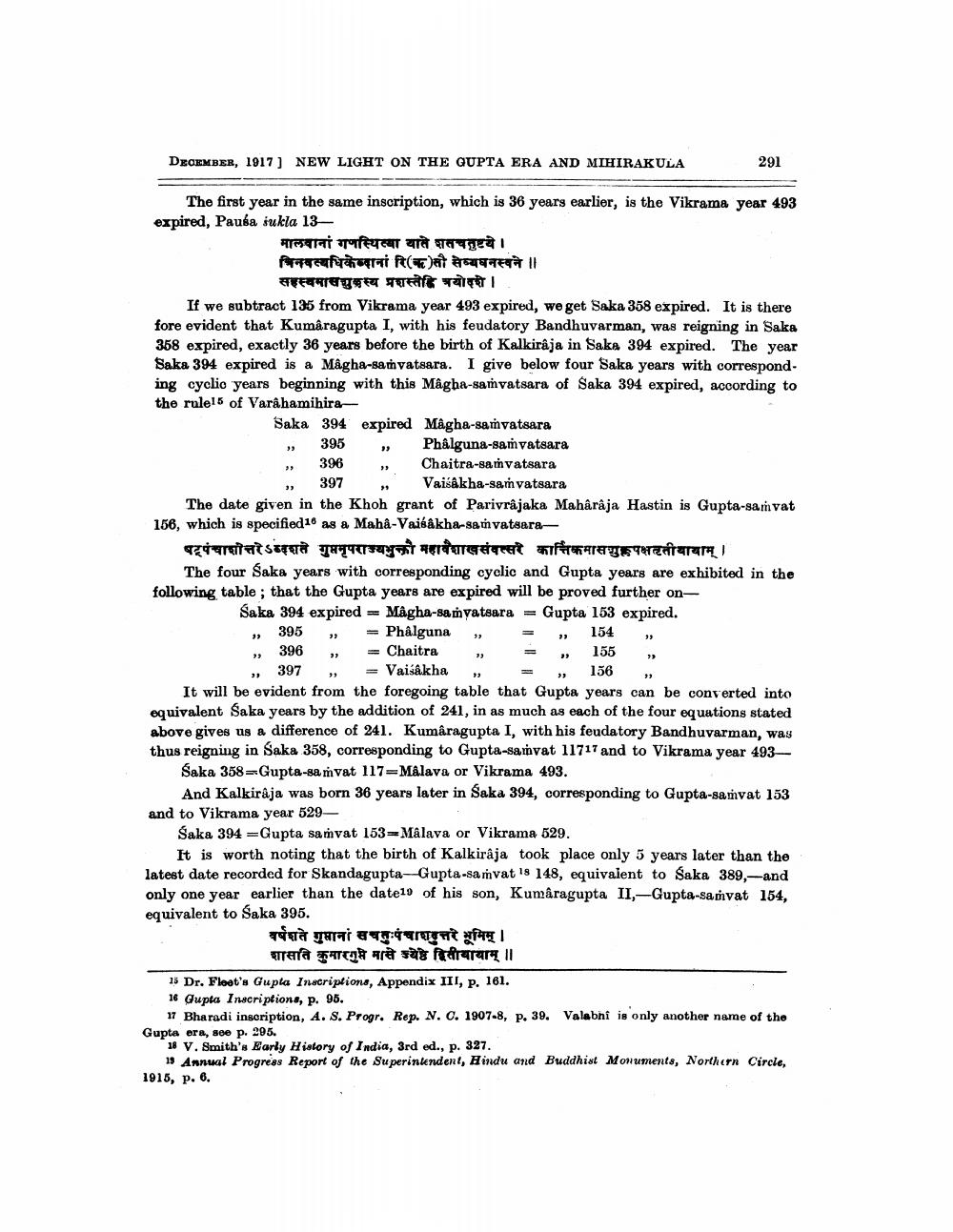________________
DECEMBER, 1917] NEW LIGHT ON THE GUPTA ERA AND MIHIRAKULA
291
The first year in the same inscription, which is 36 years earlier, is the Vikrama year 493 expired, Pausa sukla 13
मालवानां गणस्थित्वा याते शतचतुष्टये। बिनवत्यधिकेदानां रि(क)सौ सेण्यघनस्वने ॥
सहस्वमाखाकस्य प्रशस्तडि त्रयोदशे। . If we subtract 135 from Vikrama year 493 expired, we get Saka 358 expired. It is there fore evident that Kumâragupta I, with his feudatory Bandhuvarman, was reigning in Saka 358 expired, exactly 36 years before the birth of Kalkirâja in Saka 394 expired. The year Saka 394 expired is a Magha-samvatsara. I give below four Saka years with correspond ing cyclio years beginning with this Magba-samvatsara of Saka 394 expired, according to the rulels of Varahamihira
Saka 394 expired Mâgha-samvatsara , 395
Phâlguna-samvatsara 396
Chaitra-samvatsara 397
Vaisakha-samvatsara The date given in the Khoh grant of Parivrâjaka Mahârâja Hastin is Gupta-samvat 156, which is specified 16 as a Maha-Vaisakha-samvatsara
षट्पंचाशोत्तरेऽवशते गुप्तनृपराज्यभुको महावैशाखसंवत्सरे कार्तिकमासशुक्लपक्षतीयायाम् ।
The four Saka years with corresponding cyclic and Gupta years are exhibited in the following table; that the Gupta years are expired will be proved further on
Saka 394 expired = Magha-sanyatsara = Gupta 153 expired. , 395 = Phâlguna
= 154 » 396
= Chaitra , = 155 , 397 = Vaisakha
= 156 , It will be evident from the foregoing table that Gupta years can be converted into equivalent Saka years by the addition of 241, in as much as each of the four equations stated above gives us a difference of 241. Kumâragupta I, with his feudatory Bandhuvarman, was thus reigning in Saka 358, corresponding to Gupta-samvat 11717 and to Vikrama year 493—
Saka 358=Gupta-saṁvat 117=Málava or Vikrama 493.
And Kalkiraja was born 36 years later in Saka 394, corresponding to Gupta-samvat 153 and to Vikrama year 529–
Saka 394 Gupta samvat 153= Mâlava or Vikrama 529.
It is worth noting that the birth of Kalkirâja took place only 5 years later than the latest date recorded for Skandagupta-Gupta-samvat 18 148, equivalent to Saka 389,--and only one year earlier than the date19 of his son, Kumâragupta II,-Gupta-samvat 154, equivalent to Saka 395.
वर्षशते गुमानां सचतुःपंचाशतत्तरे भूमिम् ।
शासति कुमारगुम मासे ज्येष्ठे द्वितीयायाम् ।। 15 Dr. Floet's Gupta Inscriptions, Appendix III, p. 161. 16 Gupta Inscriptions, p. 95.
17 Bharadi inscription, A. S. Progr. Rep. N. C. 1907-8, p. 39. Valabhi is only another name of the Gupta ora, see p. 295.
18 v. Smith's Early History of India, 3rd ed., p. 327.
19 Annual Progress Report of the Superintendent, Hindu and Buddhist Monuments, Northern Circle, 1915, p. 6.




